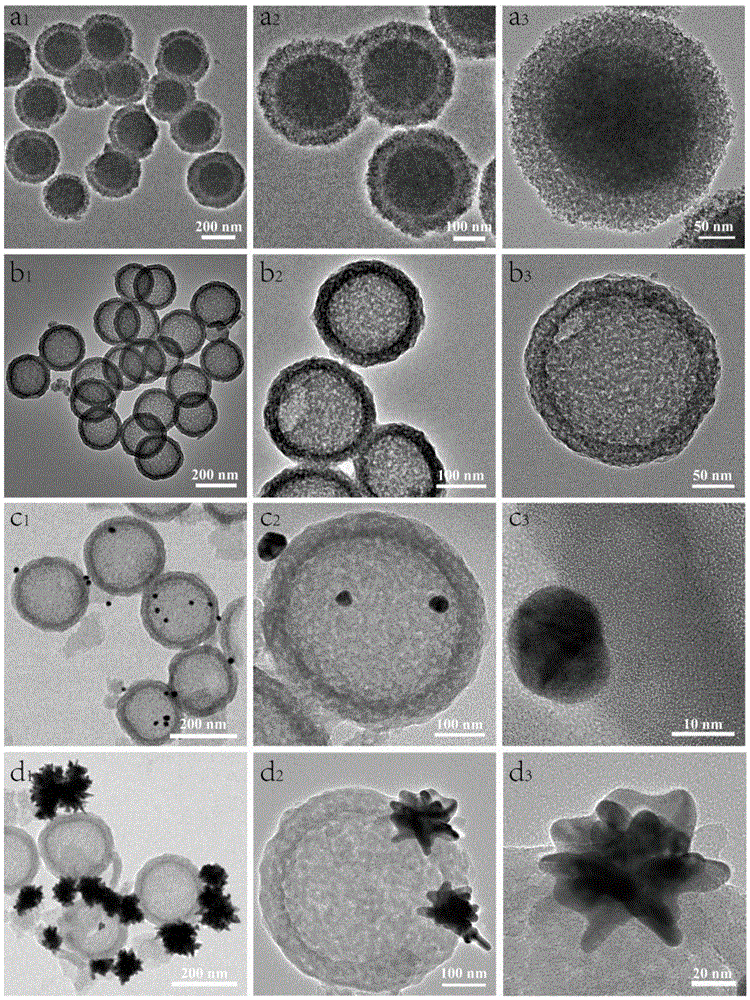Preparation method of hollow mesoporous silica loaded by nanometer star-shaped gold particles
A technology of mesoporous silica and nano-venus, which is applied to the preparation of medical preparations containing active ingredients, pharmaceutical formulas, X-ray contrast agents, etc., can solve the problems of preparation and application of multifunctional nanoparticles that have not been found
- Summary
- Abstract
- Description
- Claims
- Application Information
AI Technical Summary
Problems solved by technology
Method used
Image
Examples
Embodiment 1
[0076] The specific process of preparing HAPP nanoparticles is as follows: figure 1 shown.
[0077] (1) Mix 71.0mL of absolute ethanol, 10.0mL of ultrapure water and 3.14mL of ammonia water at room temperature, and stir in a 30°C water bath for 30min, then quickly add 6mL of tetraethyl orthosilicate (TEOS), and continue to stir for 1h. Solid silica particles (sSiO 2 ), then quickly add pre-mixed 5mLTEOS and 2mL carbooctadecyltrimethylsilane (C18TMS) mixture, continue to stir for 1h, and collect by centrifugation at 8500r / min to obtain solid silicon particles wrapped in mesoporous silicon (mSiO 2 sO 2 ). TEM test results show that: mSiO 2 sO 2 The core is solid silicon with a diameter of about 150nm, and the outer shell is mesoporous silicon with a thickness of about 30nm ( figure 2 a 1 -a 3 ).
[0078] (2) Divide the product obtained in (1) into 8 parts, and disperse them in 40mL anhydrous sodium carbonate solution (0.7M) respectively (dividing into 8 parts can make ...
Embodiment 2
[0085] The product obtained in (6) in Example 1 was configured into a 4 mg / mL mother solution with sterile PBS buffer, and then serially diluted to 2, 1, 0.5 and 0.25 mg / mL of the material. The cultured C6 cells were seeded in a 96-well plate, and inoculated at a density of 8,000 cells / well, with a volume of 100 μL per well. After culturing overnight, the above-mentioned materials of each dilution gradient were added and co-cultured with the cells for 24 hours. Each gradient was diluted 10-fold with culture medium, that is, the final concentrations in each well were 400, 200, 100, 50, 25 and 10 μg / mL. Five parallel wells were made for each gradient, and PBS buffer was used as a blank control. After the culture, wash with 100μL PBS for 3 times. One group of experiments was irradiated for 30s under ultrasonic (1MHz-1.2W / cm2, duty ratio: 50%), and the other experiment was not irradiated with ultrasonic. After that, each well of the two groups of experiments Add 100 μL serum-fre...
Embodiment 3
[0087] Get the obtained HAPP particles in (6) in Example 1 and the obtained HAP in (1) in Comparative Example 1 to be formulated with ultrapure water into materials with a concentration of 20 mg / mL and 5 mg / mL, fill the PE tubes of 2 mL respectively, and treat the two A group of materials were subjected to contrast mode ultrasound imaging test. Ultrapure water was used as blank control. The test results showed that within the range of the test concentration, the HAPP particles coated with HPF showed a better US imaging effect than the HAP particles ( Figure 7 ).
PUM
| Property | Measurement | Unit |
|---|---|---|
| diameter | aaaaa | aaaaa |
| diameter | aaaaa | aaaaa |
| diameter | aaaaa | aaaaa |
Abstract
Description
Claims
Application Information
 Login to View More
Login to View More - R&D
- Intellectual Property
- Life Sciences
- Materials
- Tech Scout
- Unparalleled Data Quality
- Higher Quality Content
- 60% Fewer Hallucinations
Browse by: Latest US Patents, China's latest patents, Technical Efficacy Thesaurus, Application Domain, Technology Topic, Popular Technical Reports.
© 2025 PatSnap. All rights reserved.Legal|Privacy policy|Modern Slavery Act Transparency Statement|Sitemap|About US| Contact US: help@patsnap.com



